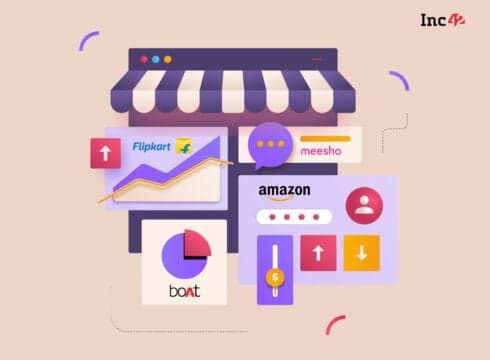Driven by the rise of digital infrastructure, ecommerce in India is set to reach $400 Bn by 2030
Ecommerce startups in India raised more than $27 Bn during 2014-2021
The rise of the Thrasio model and the emergence of content commerce have paved the way for ecommerce growth in the country
Inc42 Daily Brief
Stay Ahead With Daily News & Analysis on India’s Tech & Startup Economy
The Covid-19 pandemic has accelerated the shift towards online shopping all over the world. Consequently, the ecommerce industry saw a 77% rise in 2021 compared to the previous year, while Tier 2 and Tier 3 cities in India transacted more than ever, according to a Bobble AI (conversational media platform) report.
The ecommerce sector in India is currently at a late growth stage, given the presence of multiple players and the emergence of new business models such as direct-to-consumer or D2C, the Thrasio model of consolidation and growth and the rapid rise of social commerce. Furthermore, the country is home to more than 5K active ecommerce startups, which are pushing the advantages of digital commerce across the consumer retail segment and driving growth.
The big growth and massive potential of India’s ecommerce also attracted strong investor interest. Funding in this sector grew by more than 1000% in 2021 compared to the previous year.
Driven by government initiatives, a rise in the internet and smartphone penetration, an unprecedented growth in the number of online shoppers and the increasing popularity of the D2C model, the Indian ecommerce market is estimated to reach $400 Bn by 2030.
What The Future Holds For Ecommerce In India
Growing Popularity Of Content Commerce
Content commerce, a fast-emerging trend in the Indian ecommerce space, essentially involves the consumption of short-form videos and other content formats. This has accelerated influencer marketing, social media consumption and the development of social commerce.
The Rise Of Ecommerce Roll-Ups
The success of this Thrasio-like business model depends on assessing brand potential, acquiring them at the right price and then driving growth through increased sales, reduction in cost and enhanced operational efficiency. The disruptive model has already seen considerable interest from mainstream and debt investors. In India, a dozen or so startups are currently operating in this space, including GlobalBees, Mensa, GOAT, 10Club and others.
Immersive Shopping Experience With Integration Of New-Age Technology
As the world enters the metaverse, key trends like customised lifestyle products, virtual trial rooms (or AR/VR-assisted dress fittings) and UI animation are expected to disrupt the online shopping experience.
Market Consolidation
As the digital market gets overcrowded in the wake of the pandemic and smaller brands struggle to cope with many challenges, big-to-medium businesses are out shopping to grow their enterprise muscle and corner success. Developing a house of brands is becoming popular, and so is the Thrasio model, while new-age startups, powered by deep-pocketed VCs, are snapping up legacy players. These trends clearly indicate that the ecommerce market will witness more M&A deals in the coming years.
{{#name}}{{name}}{{/name}}{{^name}}-{{/name}}
{{#description}}{{description}}...{{/description}}{{^description}}-{{/description}}
Note: We at Inc42 take our ethics very seriously. More information about it can be found here.


